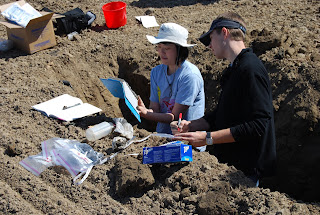The science of dirt
Much of what my research focuses on involves the chemistry and microbiology of soil. When talking to folks about it, I'll often use the word 'dirt', but the correct technical term is 'soil'. The properties of soil are very important to us. For instance the texture and structure of soil are the main factors influencing water infiltration rate. If the soil is too compacted, water won't flow through it.
We recently visit Williams Farms in Northern California to take a look the soil profile that develops in rice paddies. The picture reveals some interesting things about that environment.

For instance...
The field is about as dry as it gets, but not far below the surface, the soil color and moisture content drastically changes. The lower horizon stays saturated even when the upper horizon dries out, and this phenomena controls the colors. Single-cell microrganisms in the lower soil do not have access to oxygen, but they have the ability to breathe other chemical compounds. One such compound, Fe, is found throughout the entire soil profile. When oxygen is limited, the organisms essentially breathe rust, aka iron (3+) - iron 'missing' 3 electrons, and produce as a by product iron (2+) - iron missing 2 electrons. The upper part of this soil profile has plenty of oxygen, so the iron (2+) has reformed rust. The lower part of the profile never sees much oxygen, so the iron remains in the iron(2+) chemical form. Once the field is flooded for rice farming, the upper horizon of the soil will quickly become void of oxygen and return to a grey color.
Iron(3+) compounds are responsible for controlling nutrient and contaminant mobility in the environment. Thus, iron environmental chemistry is very important and worth understanding.

Here another student and I are taking soil samples and characterizing soil from the profile.

This is a great picture of a soil clod from the transition area between the upper and lower horizons. The patches of orange are rust and indicate where old roots used to be. During the rice growing season, roots pushed through the soil. After the field dried out and rice was harvested, the roots died and were eaten up by microorganisms. Oxygen was able to transfer through the area where the dead root used to be, and this oxygen reacted with the iron to form rust. However, the dense clay texture of the soil limited how far the oxygen could penetrate into the bulk soil, so much of the soil remained iron (2+) - the non-rust form.
Amazing, huh?!


2 Comments:
You know, that was actually pretty interesting. I've never thought much about dirt or its chemical makeup.
How will you use what you're learning? What is the purpose of the study of the rice paddies?
Yes... that is amazing. Hope you will keep sharing. I enjoy learning along with you. Love ya!
Post a Comment
<< Home